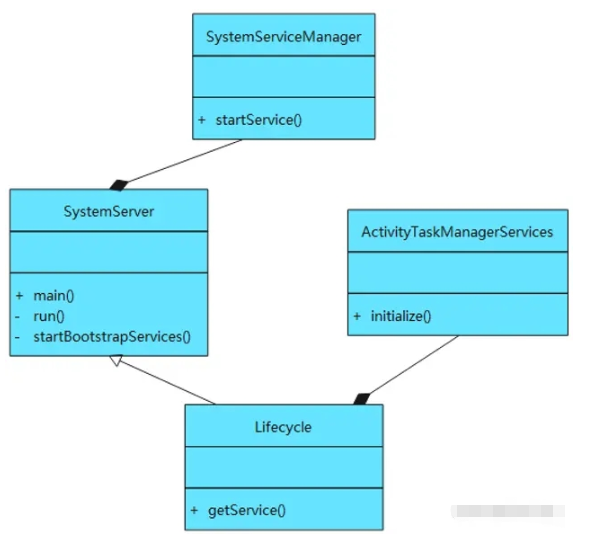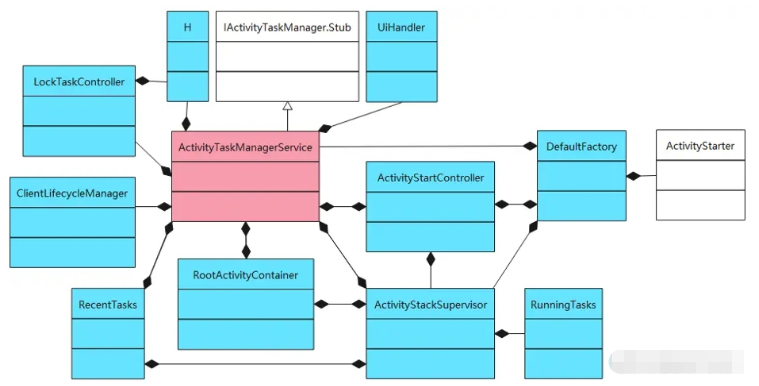这篇文章主要介绍“Android framework ATMS启动流程是什么”的相关知识,小编通过实际案例向大家展示操作过程,操作方法简单快捷,实用性强,希望这篇“Android framework ATMS启动流程是什么”文章能帮助大家解决问题。
ATMS 即 ActivityTaskManagerService,用于管理 Activity 及其容器(任务、堆栈、显示等)。ATMS 在 Android 10 中才出现,由原来的 AMS(ActivityManagerService)分离而来,承担了 AMS 的部分职责。因此,在 AMS初始化过程中(AMS启动流程),也伴随着了 ATMS 的初始化。

SystemServer:依次调用 main()、run()、startBootstrapServices(),再调用 SystemServiceManager 的 startService() 方法,并将 Lifecyle.class 传入;
SystemServiceManager :startService() 方法通过反射调用 Lifecyle 的构造方法,生成 Lifecyle 对象;
Lifecyle:构造方法中调用 ATMS 的构造方法创建 ATMS 对象,并通过 getService() 方法返回 ATMS 对象。
如图,ATMS 在初始化时创建了图中蓝色类的对象。

/frameworks/base/services/java/com/android/server/SystemServer.java
public static void main(String[] args) {
new SystemServer().run();
}/frameworks/base/services/java/com/android/server/SystemServer.java
private void run() {
try {
...
// 创建Looper
Looper.prepareMainLooper();
// 加载libandroid_servers.so
System.loadLibrary("android_servers");
// 创建系统的 Context:ContextImpl.createSystemContext(new ActivityThread())
createSystemContext();
// 创建 SystemServiceManager
mSystemServiceManager = new SystemServiceManager(mSystemContext);
LocalServices.addService(SystemServiceManager.class, mSystemServiceManager);
...
}
...
try {
//启动引导服务,ActivityManagerService、ActivityTaskManagerService、PackageManagerService、PowerManagerService、DisplayManagerService 等
startBootstrapServices();
//启动核心服务,BatteryService、UsageStatusService 等
startCoreServices();
//启动其他服务,InputManagerService、WindowManagerService、CameraService、AlarmManagerService 等
startOtherServices();
...
}
...
// 开启消息循环
Looper.loop();
}/frameworks/base/services/java/com/android/server/SystemServer.java
private void startBootstrapServices() {
...
//启动 ATMS
ActivityTaskManagerService atm = mSystemServiceManager.startService(ActivityTaskManagerService.Lifecycle.class).getService();
//启动 AMS,并将 ATMS 注入
mActivityManagerService = ActivityManagerService.Lifecycle.startService(mSystemServiceManager, atm);
...
}/frameworks/base/services/core/java/com/android/server/SystemServiceManager.java
public <T extends SystemService> T startService(Class<T> serviceClass) {
try {
final String name = serviceClass.getName();
...
final T service;
try { //通过反射调用 serviceClass 的构造方法 创建 Lifecycle 对象
Constructor<T> constructor = serviceClass.getConstructor(Context.class);
service = constructor.newInstance(mContext);
}
...
startService(service);
return service;
}
...
}
public void startService(SystemService service) {
mServices.add(service); //mServices: ArrayList<SystemService>
...
try {
service.onStart(); //调用 Lifecycle 的 onStart 方法
}
...
}/frameworks/base/services/core/java/com/android/server/wm/ActivityTaskManagerService.Lifecycle.java
public static final class Lifecycle extends SystemService {
private final ActivityTaskManagerService mService;
public Lifecycle(Context context) {//被 SystemServiceManager 的 startService() 方法调用
super(context);
mService = new ActivityTaskManagerService(context);
}
public void onStart() {
//添加 ATMS 服务,方便跨进程调用:ServiceManager.addService(Context.ACTIVITY_TASK_SERVICE, mService, false, DUMP_FLAG_PRIORITY_DEFAULT)
publishBinderService(Context.ACTIVITY_TASK_SERVICE, mService);
mService.start(); //调用 ATMS 的 start() 方法
}
...
public ActivityTaskManagerService getService() {
return mService;
}
}注意:onStart() 方法中调用 ATMS 的 start() 方法初始化(下文还会介绍)。 已通过 ServiceManager.addService() 将 Context.ACTIVITY_TASK_SERVICE 与 ATMS 绑定,因此在其他进程中可以通过如下方式获取 ATMS。
IBinder b = ServiceManager.getService(Context.ACTIVITY_TASK_SERVICE); IActivityTaskManager atm = IActivityTaskManager.Stub.asInterface(b);
/frameworks/base/services/core/java/com/android/server/wm/ActivityTaskManagerService.java
public ActivityTaskManagerService(Context context) {
mContext = context;
...
mSystemThread = ActivityThread.currentActivityThread();
mUiContext = mSystemThread.getSystemUiContext(); //ContextImpl.createSystemUiContext(getSystemContext())
mLifecycleManager = new ClientLifecycleManager();
mInternal = new LocalService(); //ActivityTaskManagerInternal 的子类
...
}start() 方法被 Lifecycle 的 onStart() 方法调用,onStart() 方法又被 SystemServiceManager 的 startService() 方法调用。
/frameworks/base/services/core/java/com/android/server/wm/ActivityTaskManagerService.java
private void start() {
LocalServices.addService(ActivityTaskManagerInternal.class, mInternal);
}mInternal 属于 LocalService 类(ActivityTaskManagerInternal 的子类),在 ATMS 的构造方法中创建。
在 AMS 的构造方法中,调用了 ATMS 的 initialize() 方法进一步初始化。
/frameworks/base/services/core/java/com/android/server/am/ActivityManagerService.java
public ActivityManagerService(Context systemContext, ActivityTaskManagerService atm) {
...
mHandlerThread = new ServiceThread(TAG, THREAD_PRIORITY_FOREGROUND, false);
...
mUserController = new UserController(this);
mPendingIntentController = new PendingIntentController(mHandlerThread.getLooper(), mUserController);
...
mIntentFirewall = new IntentFirewall(new IntentFirewallInterface(), mHandler);
mActivityTaskManager = atm;
//进一步初始化 ATMS
mActivityTaskManager.initialize(mIntentFirewall, mPendingIntentController, DisplayThread.get().getLooper());
...
}/frameworks/base/services/core/java/com/android/server/wm/ActivityTaskManagerService.java
public void initialize(IntentFirewall intentFirewall, PendingIntentController intentController, Looper looper) {
mH = new H(looper);
mUiHandler = new UiHandler();
mIntentFirewall = intentFirewall;
...
mPendingIntentController = intentController;
mTempConfig.setToDefaults(); //定义时即被创建:mTempConfig = new Configuration()
...
//new ActivityStackSupervisor(this, mH.getLooper())
mStackSupervisor = createStackSupervisor();
mRootActivityContainer = new RootActivityContainer(this);
mRootActivityContainer.onConfigurationChanged(mTempConfig);
...
mLockTaskController = new LockTaskController(mContext, mStackSupervisor, mH);
mActivityStartController = new ActivityStartController(this);
mRecentTasks = createRecentTasks(); //new RecentTasks(this, mStackSupervisor)
mStackSupervisor.setRecentTasks(mRecentTasks);
...
}在 AMS 的 start() 方法中,调用了 ATMS 的 onActivityManagerInternalAdded() 方法进一步初始化。
/frameworks/base/services/core/java/com/android/server/am/ActivityManagerService.java
private void start() {
...
LocalServices.addService(ActivityManagerInternal.class, new LocalService());
//调用 ATMS 的 onActivityManagerInternalAdded 方法进一步初始化
mActivityTaskManager.onActivityManagerInternalAdded();
mUgmInternal.onActivityManagerInternalAdded();
mPendingIntentController.onActivityManagerInternalAdded();
...
}/frameworks/base/services/core/java/com/android/server/wm/ActivityTaskManagerService.java
public void onActivityManagerInternalAdded() {
synchronized (mGlobalLock) {
mAmInternal = LocalServices.getService(ActivityManagerInternal.class);
mUgmInternal = LocalServices.getService(UriGrantsManagerInternal.class);
}
}ActivityStartController 作为 ATMS 的一个重要成员,控制了 Activity 的启动,因此我们继续跟进 ActivityStartController 的构造方法。
/frameworks/base/services/core/java/com/android/server/am/ActivityStartController.java
ActivityStartController(ActivityTaskManagerService service) {
this(service, service.mStackSupervisor,
new DefaultFactory(service, service.mStackSupervisor,
new ActivityStartInterceptor(service, service.mStackSupervisor)));
}
ActivityStartController(ActivityTaskManagerService service, ActivityStackSupervisor supervisor,
Factory factory) {
mService = service;
mSupervisor = supervisor;
mHandler = new StartHandler(mService.mH.getLooper());
mFactory = factory;
mFactory.setController(this);
...
}DefaultFactory 是 ActivityStarter 的静态内部类,负责 ActivityStarter 的创建和回收。因此我们继续跟进 DefaultFactory 类。
/frameworks/base/services/core/java/com/android/server/wm/ActivityStarter.DefaultFactory.java
static class DefaultFactory implements Factory {
...
private ActivityStartController mController;
private ActivityTaskManagerService mService;
private ActivityStackSupervisor mSupervisor;
private ActivityStartInterceptor mInterceptor;
//MAX_STARTER_COUNT = 3
private SynchronizedPool<ActivityStarter> mStarterPool = new SynchronizedPool<>(MAX_STARTER_COUNT);
DefaultFactory(ActivityTaskManagerService service, ActivityStackSupervisor supervisor, ActivityStartInterceptor interceptor) {
mService = service;
mSupervisor = supervisor;
mInterceptor = interceptor;
}
public ActivityStarter obtain() {
ActivityStarter starter = mStarterPool.acquire();
if (starter == null) {
starter = new ActivityStarter(mController, mService, mSupervisor, mInterceptor);
}
return starter;
}
@Override
public void recycle(ActivityStarter starter) {
mStarterPool.release(starter);
}
}关于“Android framework ATMS启动流程是什么”的内容就介绍到这里了,感谢大家的阅读。如果想了解更多行业相关的知识,可以关注亿速云行业资讯频道,小编每天都会为大家更新不同的知识点。
免责声明:本站发布的内容(图片、视频和文字)以原创、转载和分享为主,文章观点不代表本网站立场,如果涉及侵权请联系站长邮箱:is@yisu.com进行举报,并提供相关证据,一经查实,将立刻删除涉嫌侵权内容。